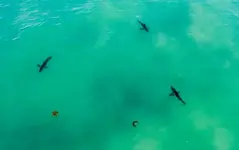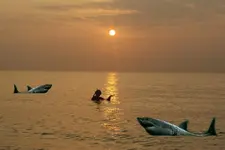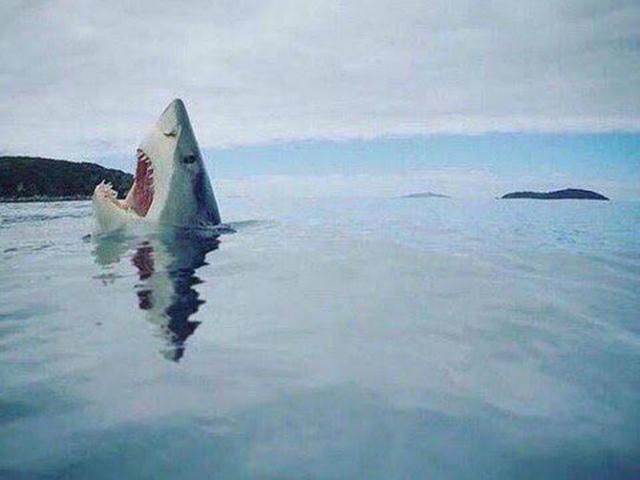
From the OCRegister:
Sharks like hot spots.
The ocean is changing.
Chris Lowe, director of the Shark Lab at Cal State Long Beach, has been studying the recent shift in great white behavior in Southern California. He and others have seen groups of great whites hanging out close to shore in areas he describes as “hot spots” in places like Santa Monica, Hermosa and Manhattan Beach, Surfside in Seal Beach, San Onofre and, most recently, Long Beach near Alamitos Bay.
“We should be worried, to an extent,” Lowe said. “But we should also be encouraged.”
Indeed, the uptick in shark sightings isn’t all bad. Over the past five decades progress has been made in protecting some marine species, he said. Great white sharks have been protected for decades against fishing, and their food sources – seals and sea lions – have been protected as well. That’s allowed all three populations to grow.
The part that’s unknown, Lowe said, is the extent to which global climate change is affecting marine animals in and near Southern California.
“Ocean temperatures are rising, causing them to live in places they’ve never lived before,” he said. “Populations are coming back. And ocean conditions may be pushing them to new places.”
Lowe saw that shift during the El Nino-dominated winter of 2014 and ’15, with a group of juvenile sharks that decided to make Surfside in Huntington Beach their year-round home. Though the sharks always have spent some time in local waters, their previous pattern was to leave the area when the water turned cool in October and November. But during that dry, warm winter, the ocean didn’t cool as much as normal and the sharks stuck around.
That held last year, too, which wasn’t so dry and wasn’t so warm.
“They didn’t migrate south in the winter, which they usually did,” Lowe said. He added that if the water temperature patterns don’t return, they “might start residing here.”
Another factor is rising sea-levels – which might be pushing great whites closer to local shores.
“There are a lot of unknowns,” Lowe said. “That’s the scary part.”
Juvenile great whites are known to hug the coast because they like to eat sting rays and other small fish. What’s unclear is why the bigger sharks have been coming so close to shore recently.
The shark that bit Corona triathlete Maria Korcsmaros in Newport Beach last Memorial Day was thought to be about 10-foot. An estimated 8-foot shark was caught from shore in Sunset Beach a few months ago, something unheard of by longtime lifeguards.
Lowe’s team has tagged sharks from Ventura to San Onofre, and they’ve set hundreds of beacons along the coast to try and track sharks’ migratory behavior.
They’ve found that the sharks like to hang out in “hot spots.” Juveniles have long been attracted to San Onofre. From 2005 — 2009, baby sharks liked an area in the Santa Monica Bay. Then, a few years ago, the hot spot shifted to Manhattan and Hermosa. In recent years it was Surfside to Sunset and, over the past few months, there’s been a group near Belmont Shore.
“One of the things we’ve seen the past 10 years, there’s shifts in how animals are using the hot spots,” he said. “Some have migrated to Baja and come back.
“We’re slowly piecing together their movement.”
There might be a “hot spot” coming to a beach near you.
On Sunday, photographer Matt Larmand captured images of a group of sharks close to shore right off Capo Beach in Dana Point. Doheny State Beach had an advisory south of the campgrounds after several shark sightings, and there was another shark sighting at Trestles, where many surfers ignored a beach closure in place after the attack to ride decent-sized waves.
The focus this summer is to find out what makes “hot spots” appealing, and Lowe also hopes to put camera-equipped “smart tags” on dorsal fins. The goal is to get some insight into what the sharks are eating and how they interact with other sharks.
Once the sharks find a beach they like, the tend to stay about 40 days. Then they’ll disappear for a while, before showing up at another hot spot.
Then, as they get older, they hop between the hot spots, sometimes in just a few hours.
“It’s kind of like watching kids mature. When they are toddlers, they can’t travel far. Then they can move very quickly, like kids on a bike,” Lowe said.
“As they get bigger, they start to expanding their world.”




 ?
?




